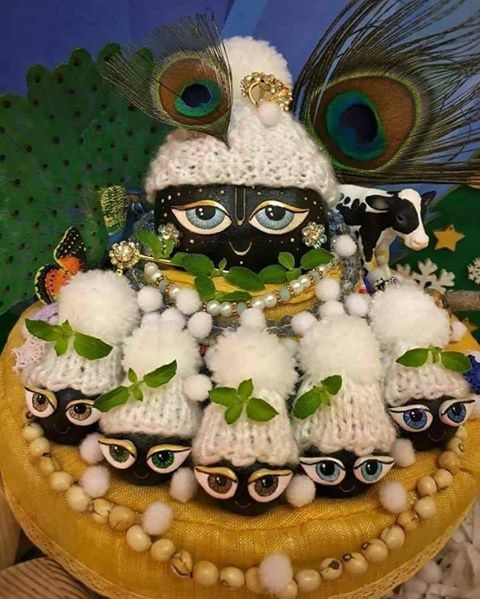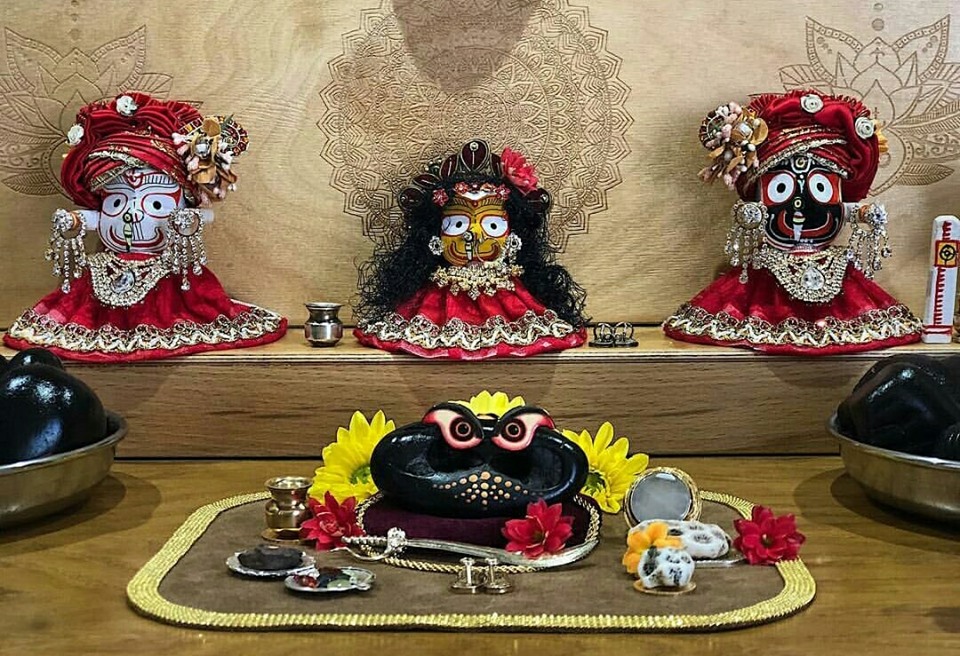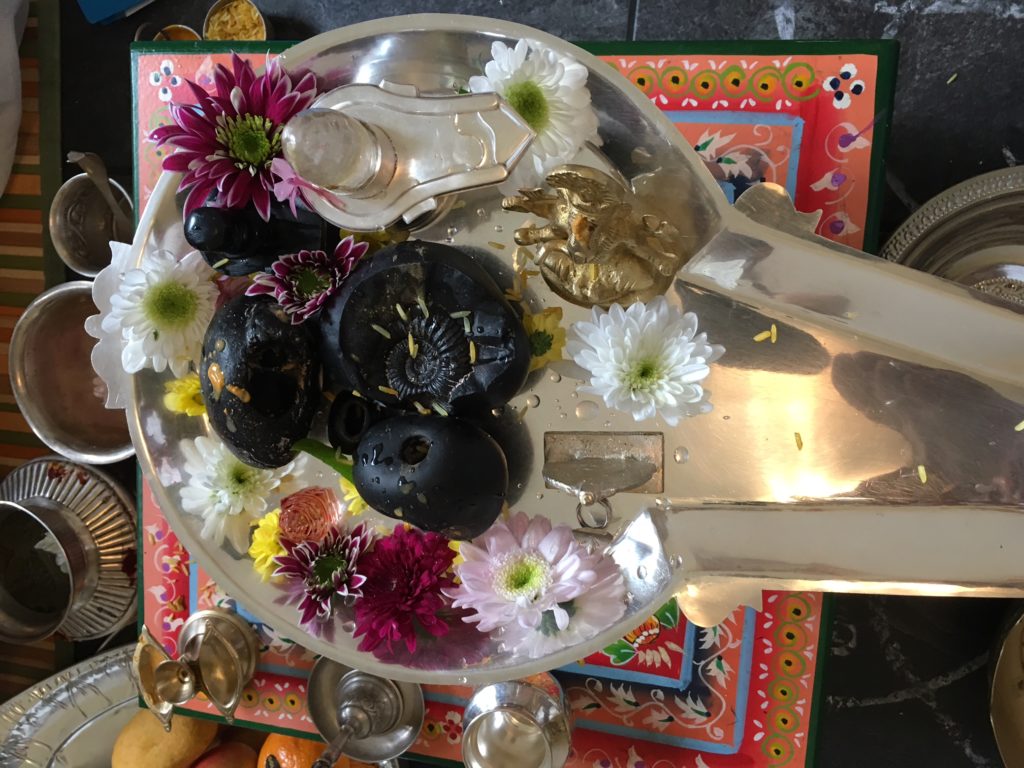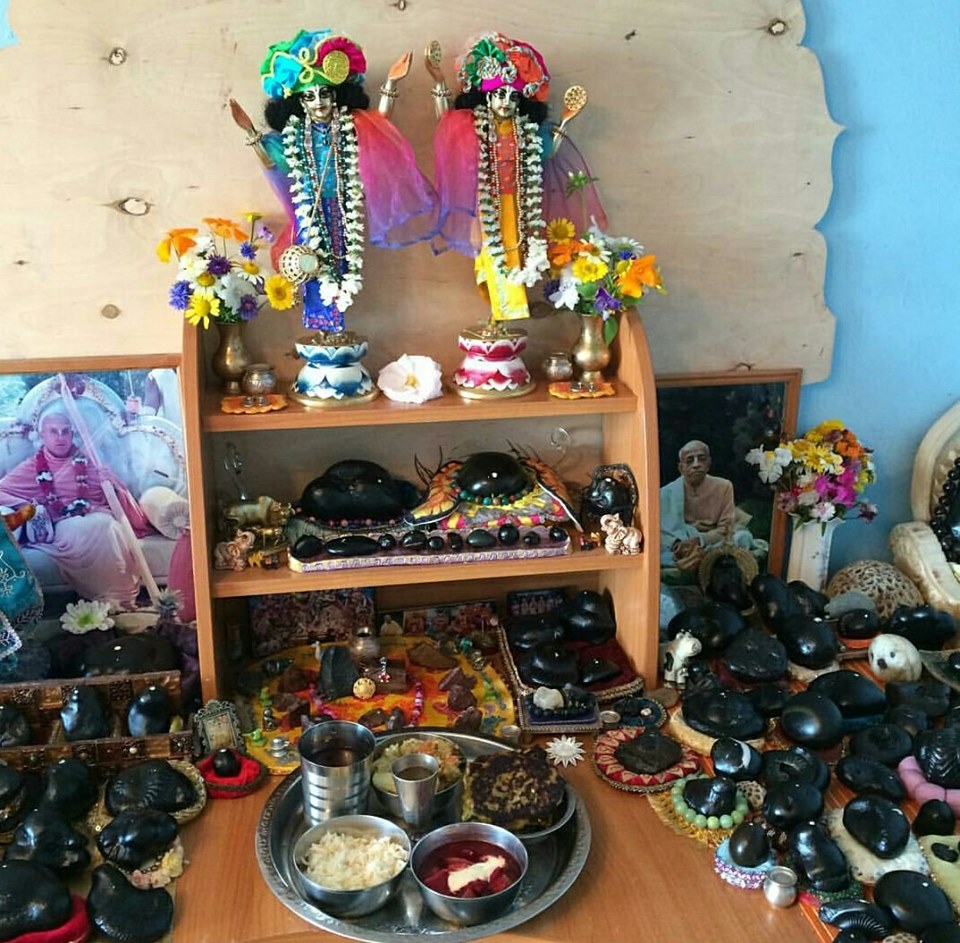Shaligram shrines are each as unique as the households that look after them.
As I move into the planning stage for my second manuscript on Shaligram interpretive traditions, I have become more and more fascinated with the specifics of Shaligram ritual practice in the home shrines of families who venerate them. I have written earlier on a number of aspects of this particular kind of home Shaligram seva (service/worship), including discussing how various family members participate in the care of the Shaligram deities, how parents bequeath specific shilas to children during important milestones (weddings, moving away, acceptance to school or graduation, funerals, etc.), and how second and third children plan their own Shaligram pilgrimages to begin building their home practices when elder children inherit the family’s collection. But what I haven’t spoken much at length about is the unique expressions of devotion built into every home mandir and into every home darshan.
As living members of the family, it should come as no surprise that Shaligrams are treated with much the same level of care and the rest of the household is. This means that their mandir (or shrines) are often reflective of things important to the rest of the family. It is not unusual to therefore include food, clothing, and other accessories for your Shaligrams and other deities to enjoy. But home shrines are very often more complicated than that, so I have posted a series of photos taken from specific home shrines along with a short commentary to better demonstrate what I mean.
Krishna with Hats

I love this Vaishnava home darshan. The story behind
it is that the household, in this case, happens to be in a region that gets
very cold during the winter. As such, one of the elderly women of the family
knitted caps for the deities so that they wouldn’t find the temperature so
unpleasant. This mirrors, to some degree, a common practice in temple deity
worship wherein sandalwood paste (which is very cooling when placed on the
skin) is painted over the deities and Shaligrams during especially hot days in
order to make them more comfortable. But this is not the first time I have seen
warm clothes for murti. Many temples in colder climates have sweaters
and wraps on hand for the deities just as much as they have the kinds of typical
dhotis, saris, and tunics which are the standard for dressing icons. Either way,
though, the hats are incredibly cute and when added to these Krishna Gopala
Shaligrams (Krishna as a young child), they seem even more fitting.
You will also likely notice the eyes (as objects attached to the smaller
Shaligrams and painted on to the larger one). Adding eyes, faces, and certain
expressions is extremely common in Shaligram worship and is described as
assisting practitioners in “taking darshan†(a type of ritualized exchange of
gazes where one views the deity and is viewed by the deity in return). This
does not mean that Shaligrams without the inclusion of eyes cannot “see†their
devotees (they can) but only that they act as a focal point for ritual
practice. For many people, it’s just easier to interact with a face.
Lastly, these Shaligrams have recently received their daily offering of tulsi
leaves. Tulsi (a type of holy basil) and water are, generally speaking, the two
most basic parts of Shaligram worship to such a degree that, if these two
things are the only things a family is capable of offering their home deities,
it is considered enough and the Shaligrams are content.
Narasimha Jagannatha

Next to Krishna and Shiva, Narasimha is probably the
third most commonly sought after Shaligram. Unfortunately, it is also one of
the hardest to find. Comprised of two internal chakras and a wide open vadana
(mouth) this Shaligram must also demonstrate notable “teeth†in the ridges near
the edge of the mouth (formed by the incomplete wearing of the internal
structures of the ammonite). I particularly like this Ugra Narasimha Shaligram
(which has smoother chakras and a larger vadana than other types of Narasimha
Shaligrams) because of the eyes the family has added to his face. To me, he
looks both simultaneously fierce and adorable. Or perhaps he just knows that he
is adorable and is especially mad about it. In any case, this simpler home
shrine keeps the primary household deity, the self-manifest Narasimha Shaligram,
at the forefront and in the center, and all other murti, such as the Jagannath
icons, along the back.
Smarta Abisheka

One of my fondest memories of fieldwork was participating
in a four-hour abisheka (bathing ritual) for a Brahmin household’s Shaligrams.
It was an all-day community event with food, conversation, and, of course, talk
of Shaligram pilgrimage. This was largely due to the fact that the patriarch of
the household in question had just gone on his very first Shaligram pilgrimage
to Nepal and was excited to welcome the new family members (seen here) home.
Abishek is one of the typical ways new Shaligrams are welcomed into a
household. One of the reasons for this is that Shaligrams are said to “take
birth†out of the Kali Gandaki River and, as such, water is an integral part of
their worship. Another reason for this is that the bathing ritual and
subsequent pujas tend to mirror the river birth of the Shaligrams as a
kind of secondary rebirth into the family. In other words, Shaligrams are first
born into the world through the Kali Gandaki and then born again into their new
households and families through abishek. Unsurprisingly, I have known a
great many pilgrims to also collect water from either the Kali Gandaki or from
the water spouts at the temple of Muktinath (the high-altitude temple at the
end of the Shaligram pilgrimage route in Mustang) to bring back home with them
and use for precisely this purpose. The most extreme versions of this even
involve pilgrims who keep their newly found Shaligrams in containers of river
water, completely immersed until they get home. This way, their Shaligrams are,
in effect, born only once and always directly into the family.
Hare Krishna Shaligram Seva

One of the fastest growing groups of Shaligram practitioners the world over are undoubtedly the Hare Krishnas. In fact, many Shaligram sellers I worked with in Nepal and in India described Hare Krishnas as their largest set of clienteles who are usually looking to purchase specific Shaligrams. There are a number of reasons for this, despite the typical ban on buying and selling sacred stones. One reason is that many Hare Krishnas do not live in South Asia and cannot afford to undergo pilgrimage to Nepal. Additionally, as many Hare Krishnas are not of South Asian descent, they might be barred from entering certain shrines or temples or they may face exorbitant permit and travel fees when attempting to access certain sacred landscapes (Mustang being one of them, as there are different permit prices for Indian and Nepali pilgrims versus all other foreign passport holders). Unfortunately, many Hindus and Buddhists in South Asia also have extremely ambiguous feelings about Hare Krishna practice and some have (very founded) concerns about the rate at which foreigners are purchasing Shaligram stones, particularly online. In effect, as more and more foreign practitioners are willing to spend hundreds, if not thousands, of dollars on a Shaligram, the price of available stones goes up and more stones are collected from the depleted reserves of the Kali Gandaki River Valley, rendering many Shaligrams completely out of reach for poorer devotees.
On the other hand, many practitioners have noted that the spread of Shaligram seva to the Hare Krishnas has meant the preservation and continuation of ritual traditions that were, and very much still are, in danger of going extinct. Hare Krishnas, for example, have been some of the first Shaligram devotees to begin writing down Shaligram descriptions and interpretations or compiling different rules for Shaligram puja and sharing those texts with others. As with most things, popularity has its pros and cons.
Size Doesn’t Matter
Lastly, I want to note that one of my personally favorite things about Shaligram darshan, and really home darshan in general, is the use of miniatures to represent or re-create a variety of divine worlds on the small scale. It is not unusual, for example, for ritual practitioners to include small sets of household objects (almost like doll-house furniture and accessories), miniature animals, and other accoutrements of every day life with their murti right alongside the tiny pairs of shoes, clothes, dishes and water cups, and jewelry present in almost every type of darshan. In one especially elaborate home shrine I had the privilege of experiencing, the family had used a collection of Shopkins (tiny, collectible, toys in the shape of anthropomorphic grocery items) to construct an entire smiling feast for the benefit of the household murti. While one might view this particular set-up as bizarrely indicative of late-stage capitalism, what I want to emphasize here is that the use of such objects as ritual offerings or to create new miniature realms for deities to inhabit has a history that predates Moose Toys and Hasbro by about four thousand years. In this case, the fact that Shopkins miniatures are manufactured and sold widely just means they are more accessible to the average family than more expensive hand-made items might be. In the end, it isn’t the nature of object offered that really counts but the spirit within which it is given. And besides, even deities like to have a little fun, right?
